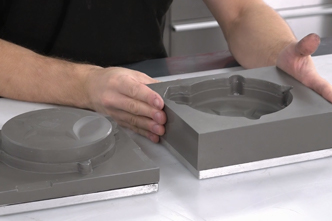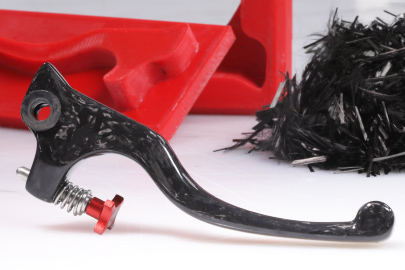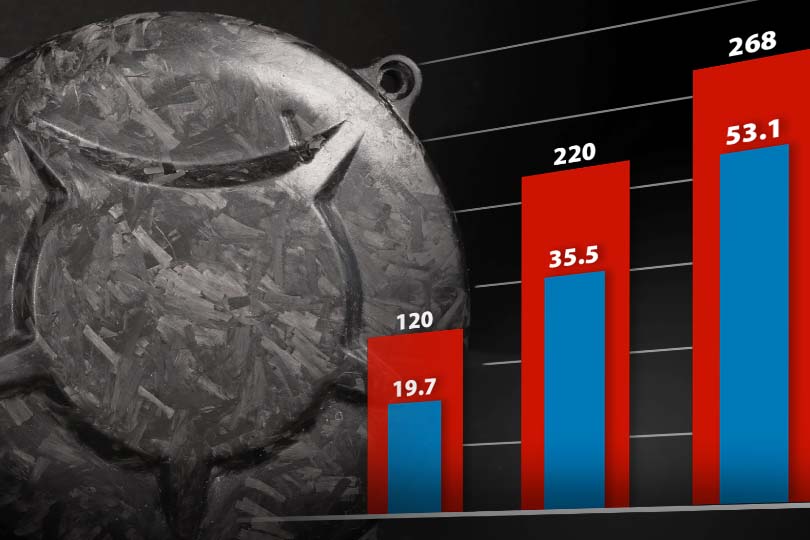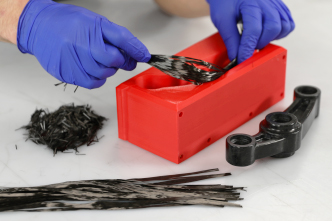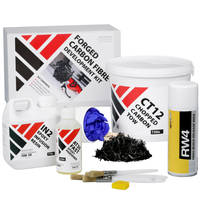Heb je hulp of advies nodig?+44 (0)1782 454499
Downloads (1)
| Gesmeed koolstof voorbeeld compressie mallen CAD-bestanden |
VIDEO'S IN DEZE SERIE
Deze video is deel 2 van een serie in 4 delen:PRODUCTEN GEBRUIKT IN DIT PROJECT
Hoewel dit niet per se een uitputtende lijst is, werden de volgende gereedschappen en materialen, geleverd door Easy Composites, in dit project gebruikt.
De hoeveelheid die hieronder wordt weergegeven, is de geschatte hoeveelheid die in het project wordt gebruikt, afgerond naar de dichtstbijzijnde beschikbare kitgrootte of hoeveelheid.
MATERIALEN & VERBRUIKSARTIKELEN
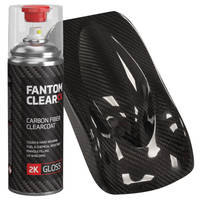
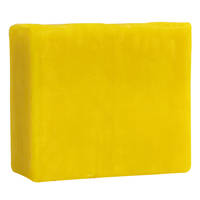
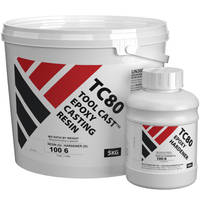
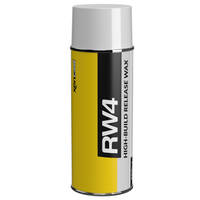
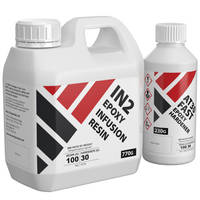
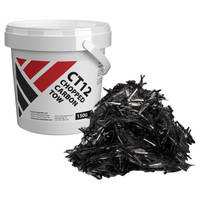
VIDEO HANDLEIDING
Hoe Gesmede Koolstofvezelonderdelen Persen
In deze videotutorial over composieten laten we zien hoe je solide, hoogwaardige, gesmede koolstofvezelonderdelen maakt met behulp van een tweedelige compressiemal.
In de tutorial gebruiken we een tweedelige compressiemal met een speciale epoxy giethars en een driedelige mal met een conventionele FDM-printer. In de tutorial gebruiken we de materialen uit de Forged Carbon Fibre Development Kit van Easy Composites.
WAT JE ZULT LEREN
In deze videotutorial maken we hoogwaardige, massief gesmede koolstofvezelonderdelen met behulp van een compressievormmethode op omgevingstemperatuur. We werken met 2 soorten mallen: een gietmal van hars en een 3D-geprinte mal.
Deze handleiding kan worden gevolgd om gesmede koolstofvezelonderdelen te maken die de prestaties van metalen in veel toepassingen evenaren of zelfs overtreffen en behandelt de volgende onderwerpen:
- Ontwerp van compressiemallen
- Geschikte materialen voor matrijzenbouw
- Vormvoorbereiding en aanbrengen van lossingsmiddel
- Vezel- en harshoeveelheden berekenen
- Lamineren/laadmethoden
- Compressiemethoden voor matrijzen
- Ontvormen en afwerken
INLEIDING
Gesmede koolstofvezel is de term die wordt gebruikt om korte of 'gehakte' strengen koolstofvezel te beschrijven die worden samengeperst in meerdelige matrijzen om sterke vaste geometrieën te creëren die niet praktisch zouden zijn met conventionele composietprocessen.
Er zijn 2 fundamentele benaderingen voor het maken van een gesmeed koolstof onderdeel, de ene is het gebruik van een vooraf geïmpregneerd (prepreg) gehakseld touw en dit gieten onder hitte en druk, de andere is het gebruik van een droog vezel en vloeibaar harssysteem en gieten onder druk maar zonder hitte. Deze projectgids richt zich op de laatste, maar het algemene principe en de principes van matrijsontwerp zijn gemeenschappelijk voor beide materiaalsoorten.
Onderdelen die met deze methode zijn vervaardigd, hebben volledig gegoten oppervlakken, kunnen verschillende wanddiktes hebben en bieden uitstekende mechanische prestaties die in veel toepassingen kunnen worden gebruikt in plaats van metalen om het gewicht te verlagen.
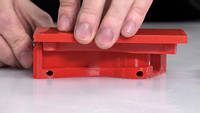
Grondbeginselen van het ontwerp van compressiematrijzen
Compressiematrijzen bestaan uit 2 of meer delen die in elkaar passen en een holte vormen waarin het onderdeel wordt gevormd. In bijna alle gevallen is de matrijs blokvormig om stevigheid te bieden en het klem- of compressieproces praktisch te maken.
De belangrijkste overweging bij het ontwerpen van matrijzen voor dit proces is om een telescopisch deel op te nemen waarbij het mannelijke gereedschap tijdens het sluiten als een zuiger in een cilinder werkt. Hierdoor is er ruimte om de niet-gecomprimeerde vezel te laden en tijdens het sluiten wordt overtollig hars door de scheidingslijn naar buiten geperst, maar omdat het zeer nauw aansluit, kan de vezel niet ontsnappen waardoor je de juiste vezel/harsverhouding houdt. Dit telescopische of 'zuigerachtige' element moet diep genoeg zijn om de mal te laten sluiten voordat de vezel wordt verstoord. De exacte grootte van dit element hangt af van de vorm en het ontwerp van de mal, maar een algemene regel is dat het element minstens 25% van de diepte van het uiteindelijke onderdeel moet bedragen. In het geval van een 2-delige matrijs heeft deze vorm een lichte trekhoek van 2-3 graden nodig om de matrijs gemakkelijk te kunnen scheiden. Bij meerdelige matrijzen is het vaak mogelijk om de matrijs zo te ontwerpen dat deze kan worden gescheiden van een volledig parallelle 'zuiger'.
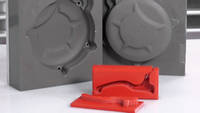
Materialen voor matrijsbouw
Voor volumeproductie worden compressiematrijzen voor dit proces over het algemeen gemaakt van machinaal bewerkt aluminium of staal. Deze matrijzen bieden uiteraard een uitstekende sterkte en duurzaamheid, maar zijn duur om te produceren, waardoor ze minder geschikt zijn voor kleine series en prototypes.
Een alternatief voor billet metalen gereedschappen zijn epoxy gietgereedschappen. In dit project gebruiken we gietgereedschappen die gegoten zijn in TC80 giethars. Dit voorbeeld is gemaakt door de gietstukken van een bestaand spuitgietonderdeel te nemen, maar het kan ook gegoten worden van een conventioneel patroon of een 3D-print. De resulterende gereedschappen van giethars zijn zeer sterk en duurzaam en zouden tientallen, zo niet honderden onderdelen moeten kunnen produceren zonder overmatig te slijten. Zie voor meer informatie over deze gereedschapsmethode ons project giethars compressiegereedschap.
Een andere tooling methode die we in dit project zullen gebruiken is direct 3D geprinte PETG plastic tooling. Hoewel dit niet de sterkte en duurzaamheid van massieve mould tooling biedt, heeft het wel het voordeel dat het erg goedkoop en snel te produceren is en erg handig kan zijn voor kleine series en eenmalige prototypes. Door dit proces te gebruiken met een 3D geprinte mal kun je effectief onderdelen produceren met echt hoge mechanische prestaties zonder verdere specialistische apparatuur of tooling. Hiervoor hebt u een goed geconfigureerde en ingestelde FDM-printer nodig. Voor dit project hebben we de uitstekende Ultimaker S5 gebruikt, die met zijn voorinstellingen en intuïtieve gebruikersinterface 3D-printen eenvoudig maakt, maar u kunt natuurlijk elke printer gebruiken die goed is geconfigureerd. Als u op zoek bent naar advies over 3D-printen, bevelen we graag onze leverancier Dynamism aan. Hoewel er ook andere filamenten kunnen worden gebruikt, hebben we gemerkt dat PETG goede lossende eigenschappen heeft en nauwkeurig en gemakkelijk te printen is, waardoor het een uitstekende keuze is. Bij het printen van compressiematrijzen moet de vulling ongeveer 75% of hoger zijn om voldoende sterkte en stijfheid te bieden tijdens het comprimeren. Ook het gebruik van een laaghoogte van 0,15 mm of minder zorgt voor een beter oppervlak voor het loslaten.
Klanten die willen experimenteren met de echte mallen die in de video worden getoond, kunnen de CAD-bestanden van de gesmede koolstofvezel compressiemallen downloaden die de remhendel-, schakelpaddle- en drijfstangmallen bevatten in zowel IGES- als STL-bestanden; let op: de STL-bestanden zijn één bestand per malsectie.
WAT JE NODIG HEBT
Benodigde materialen en apparatuur voor het onderdeel
Lossingsmiddel
RW4 high build spray release wax is het aanbevolen lossysteem voor compressievormen bij omgevingstemperatuur. Dit lossingsmiddel presteert bijzonder goed bij het van elkaar losmaken van harde vormen en gietstukken omdat het een dikke barrière vormt die relatief zacht is en dus een beetje kan bewegen tijdens het losmaken indien nodig.
Fileerwas
Fileerwas en/of plasticine is vaak nuttig voor het afdichten van schroefdraad op boutdraden van matrijzen of voor het opvullen en afdichten van uitwerpgaten in de matrijs.
Gehakt touw
CT12 gesneden touw is perfect geschikt voor dit proces, het heeft strengen van 12 mm lang die een geweldige balans bieden tussen vormbaarheid en sterkte.
Epoxyhars
Het IN2-hars blijkt een uitstekende wet-out en vloei te bieden in dit proces, wat cruciaal is voor succesvol gieten.
PROJECTVERDELING
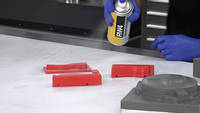
1. Bereid de mal voor
De mallen moeten worden geïnspecteerd en gecontroleerd op mogelijke ondersnijdingen of onvolkomenheden die een probleem kunnen vormen bij het vrijgeven. In het geval van een 3D-geprinte mal is het mogelijk dat het schaven van de hoeken met een mes de nauwkeurigheid van de sluiting verbetert. Zodra de mallen zijn gecontroleerd, kan het lossingsmiddel worden aangebracht.
De RW4 spraywax wordt aangebracht door een dunne laag over de mal te spuiten en deze ongeveer 5-10 minuten te laten drogen en dan opnieuw aan te brengen. Meestal zorgen 3 of 4 dunne lagen voor voldoende lossing, probeer de wax niet in één dikke laag te spuiten omdat het dan veel langer duurt om meerdere dunnere lagen te drogen. Het lossingsmiddel moet op alle oppervlakken en de scheidingsvlakken van de mal worden aangebracht, omdat de hars hier tijdens het comprimeren in zal drijven.
Eventuele uitwerpgaten in de mal moeten nu worden afgedicht met vullingswas, deze moeten stevig worden opgevuld tegen een harde stop omdat ze anders door de druk van het gietproces naar buiten worden geperst. Van alle bouten in de mal moet de schroefdraad worden gevuld met vulwas om te voorkomen dat ze vastkleven in de mal.
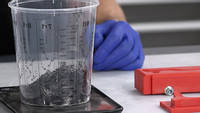
2. Bereken de benodigde hoeveelheid vezels
Het nauwkeurig berekenen van de juiste vezelbelasting voor de mal is waarschijnlijk de belangrijkste factor om dit proces tot een succes te maken. De eerste stap in het berekenen van de benodigde hoeveelheid vezel is om eerst het volume van het afgewerkte onderdeel te weten. Als er vanuit CAD wordt gewerkt, is dit heel eenvoudig en kan het worden opgezocht in het eigenschappenvenster van een solid body. In het geval van matrijzen die zijn gemaakt van een bestaand onderdeel, wordt het volume meestal berekend door het originele onderdeel te wegen, te refereren aan de dichtheid van het materiaal waarvan het is gemaakt en op basis daarvan het volume te berekenen. Als we bijvoorbeeld een spuitgegoten onderdeel hebben dat 100 gram weegt en is gemaakt van nylon 6 met 30% glasvezel (PA6 GF30), dan is de dichtheid hiervan 1,3 gram per kubieke centimeter, dus onderdeelgewicht / dichtheid = volume of 100 / 1,3 = 76,92.
Zodra het volume van het onderdeel bekend is, kan het gewicht van het afgewerkte gesmede carbon onderdeel worden berekend. Voor een snelle berekening op basis van een bekend volume kun je een vereenvoudigde methode gebruiken waarbij 0,84 g/cc wordt gebruikt voor de berekening van je vezel, maar om de reden beter uit te leggen wordt de volgende basismethode gebruikt: De dichtheid van gesmede koolstofvezel is meestal 1,4 g/cc, dus in ons vorige voorbeeld dichtheid * volume = onderdeelgewicht dus 1,4 * 76,92 = 107,69
Nu we het uiteindelijke gewicht van het onderdeel hebben, kunnen we de hoeveelheid vezel berekenen die nodig is om de optimale verhouding vezel/hars te verkrijgen. Voor dit proces is de verhouding meestal 60/40 (vezel/hars) op basis van gewicht. We kunnen dus de hoeveelheid vezel berekenen die we nodig hebben door simpelweg het gewicht van het afgewerkte onderdeel te vermenigvuldigen met 0,6, dus in ons voorbeeld: 107,69 * 0,6 = 64,61 g CT12 vezel.
De benodigde vezel moet nauwkeurig worden afgewogen in een aparte container die vervolgens kan worden gebruikt tot hij leeg is bij het lamineren van het onderdeel.
3. Bereken de benodigde hoeveelheid hars
De benodigde hoeveelheid IN2-hars kan snel worden geschat door een batch te mengen die 25% zwaarder is dan de berekende hoeveelheid vezel, dus in ons voorbeeld hebben we vezelgewicht 64,61 * 1,25 = 80,76 g IN2-hars (gemengd). Deze eenvoudige methode geeft je het overschot aan hars dat nodig is voor dit proces, veel van deze hars zal er tijdens het proces uitgeperst worden, het uiteindelijke onderdeel zelf zal 43,08g hars bevatten[107,69(eindgewicht) - 64,61(vezelgewicht) = 43,08g] afhankelijk van de grootte en complexiteit van het onderdeel dat je produceert kan je extra hars nodig hebben om het onderdeel effectief te lamineren, dit kan naar behoefte gemengd worden tijdens het lamineren.
De hars mag alleen direct voor gebruik worden gemengd, zoals met alle epoxies is nauwkeurig afwegen en mengen volgens de instructies essentieel.
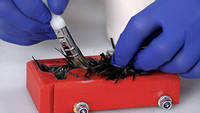
4. Lamineer het onderdeel
Lamineren in dit gesmede proces is eigenlijk vergelijkbaar met een typisch natlijmproces; op de mal moet eerst een dunne laag hars worden aangebracht met een borstel, dit helpt om de eerste laag vezel te hechten en zorgt ervoor dat het hele oppervlak goed nat wordt. De vezel moet dan lichtjes over het oppervlak worden gestrooid en worden geconsolideerd en bevochtigd door met een borstel te vegen tot de vezel verzadigd is en vervolgens worden herhaald tot de malholte gevuld is. Stomp gereedschap of 'dibbers' zijn vaak handig om de vezel in krappe en gedetailleerde gebieden te drukken. Tijdens dit proces lijkt het alsof er meer vezel is dan in de mal past en is de holte te vol. Dit is normaal en wordt tijdens het comprimeren in de holte geperst.
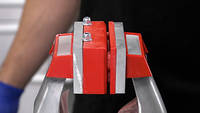
5. Sluit de mallen en druk ze samen
Als alle vezels in de matrijzen zijn geladen, kunnen ze worden gesloten en samengedrukt. Voor kleinere matrijsgereedschappen biedt een bankschroef of G-klemmen voldoende klemdruk, voor grotere matrijzen kan een pneumatische of hydraulische pers geschikt zijn. Als de matrijs is samengedrukt is het belangrijk om de matrijs langzaam te sluiten, vooral bij kwetsbaardere matrijzen zoals die zijn geprint. De reden om langzaam te sluiten is om de hars de tijd te geven in de holte te stromen en overtollige hars eruit te laten lopen. Als de mal te snel gesloten wordt, kan dit een hydraulische vergrendeling veroorzaken waardoor er een enorme kracht op de mallen komt te staan die ze mogelijk beschadigen. In de meeste gevallen kunnen de gereedschappen geleidelijk worden vastgeklemd in ongeveer 5 minuten. Zodra de gereedschappen elkaar volledig raken of 'op de bodem' liggen, moet het onderdeel onder druk blijven totdat het harssysteem is uitgehard.
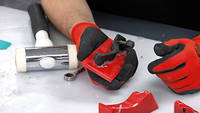
6. Afwerking
Na het ontvormen blijft er wat spatten achter bij de deellijnen. Dit kan snel verwijderd worden met een scherp mes of schuurpapier, resten losmiddel kunnen effectief verwijderd worden met matrijzenreiniger of een vergelijkbaar oplosmiddel. Hoewel deze onderdelen bijna al hun potentiële structurele prestaties direct uit de mal hebben, kan een verwarmde post-cure worden uitgevoerd om de eigenschappen van de hars te maximaliseren. Raadpleeg het technische informatieblad van de IN2 voor meer informatie.
Het onderdeel kan direct uit de mal volledig worden gebruikt, maar als het onderdeel bedoeld is voor een cosmetische toepassing, kan een glanzende afwerking met blanke lak de voorkeur hebben. Deze kan worden gespoten met een 2k blanke lak of met een kwast worden aangebracht met XCR-coatinghars. Om een van deze afwerkingen voor te bereiden, moeten de onderdelen voor het aanbrengen worden geslepen en vlak worden gemaakt met 400 grit nat en droog.
Een andere afwerkingsmogelijkheid waarbij geen extra coating nodig is, is om het ruwe ontvormde deel vlak te schuren tot een fijne korrel 1200 en vervolgens een polijstmiddel met autowas aan te brengen voor een ruwe satijnen afwerking.
DISCUSSIE (23)
Laat het ons weten als je vragen of opmerkingen hebt over deze videotutorial.
Het volume van de Paddle Shifter is 28,6 cm³.
Het is niet iets wat we ooit gedaan hebben. In wezen zou je het meer moeten ontwerpen als een spuitgietmatrijs met een pad voor hars naar binnen en ontluchtings-/vacuümpaden voor lucht en overtollige hars naar buiten. 3D-prints kunnen het ook moeilijk hebben onder vacuüm, wat je opties voor matrijsmaterialen beperkt.
Ja, dat is mogelijk, maar 1,5 mm is wel de ondergrens van de wanddikte die je realistisch gezien met dit proces zou kunnen gieten. Of je deze ribben of flenzen met succes kunt gieten, hangt af van de specifieke geometrie (hoe diep zijn ze bijvoorbeeld), hoe je de mal splitst en de vorm van de totale mal. U kunt zich waarschijnlijk de factoren voorstellen die het proces helpen of hinderen, met name de primaire 'richting' van de compressie als de malhelften bij elkaar worden gebracht. Er zijn bepaalde posities waarin deze ribben of flenzen zich kunnen bevinden waardoor ze vormbaar zijn, maar er zijn andere posities waarin ze zich kunnen bevinden waardoor het bijna onmogelijk is om ze op te vullen en vervolgens succesvol samen te drukken. Als u wat praktische ervaring opdoet met het proces op een eenvoudiger onderdeel, krijgt u waarschijnlijk een goed inzicht in wat realistisch is en wat niet voordat u het complexere onderdeel probeert.
Het is misschien mogelijk om dat te doen. Je zou moeten zorgen voor een zorgvuldige plaatsing voor het beste effect. Je zou ook een aantal bezwijkproeven kunnen doen om te zien of de bezwijkmethode iets ongewenst doet wanneer de twee materialen zich anders gaan gedragen bij hoge belastingen.
Het is geweldig om te horen dat je de sprong hebt gewaagd! Laat ons weten hoe het gaat, het zou geweldig zijn om meer onderdelen te zien die klanten met de kit hebben gemaakt. We hebben al een paar goede voorbeelden gezien, maar het is fascinerend om de verschillende onderdelen te zien die mensen maken.
Ja, dat zou kunnen. Ten eerste, afhankelijk van het plastic dat u hebt gebruikt voor de 3D print en het type high-build primer dat u gebruikt, kan het zijn dat de verf reageert met de 3D print, of in ieder geval iets zachter wordt, dus ik zou aanraden om dit eerst te testen. Ten tweede kunt u ook problemen ondervinden om de epoxycomponent goed los te laten van de mal als u deze met primer hebt behandeld. Dit is zeker niet zeker, maar het oplosmiddel in spuitlakken, inclusief primers, heeft vaak een negatief effect op het lossingsmiddel (in dit geval de spuitwas) waardoor het onderdeel in de mal kan blijven plakken, of, net zo waarschijnlijk, dat de primer loslaat van de mal maar vast blijft zitten aan je onderdeel. Nogmaals, als je deze route wilt volgen, plan dan eerst een test.
Als je het oppervlak van je mal op een meer betrouwbare manier wilt verbeteren, overweeg dan het gebruik van een gespecialiseerde epoxy coatinghars, zoals onze XCR Epoxy Coatinghars, die kan worden toegepast op 3D-prints en een betrouwbare, volledig compatibele schaal creëert waar je zonder problemen uit kunt komen. Je ziet hoe we deze hars toepassen op een 3D print in onze tutorial over de omhulling van een drone.
Dit hangt volledig af van het gebruikte harssysteem. Sommige kunststoffen, zoals PETG, laten van nature los van harsen. Als de gebruikte kunststof een type kunststof is dat van nature loslaat, dan betekent de gladdere afwerking van met hars geprinte onderdelen waarschijnlijk dat ze iets gemakkelijker loslaten.
Er wordt een inzetstuk in de hefboom gelijmd om de schroefdraad te ondersteunen. Gesmeed koolstofvezel is niet sterk genoeg om een draad te dragen die erin wordt gesneden.
Het is een hogere viscositeit dus het is misschien niet zo effectief, vooral voor grotere onderdelen. Je zou de hars en mal voorzichtig kunnen verwarmen maar je moet oppassen voor de exotherme runaway die kan optreden. De compressiefase moet zeker worden vertraagd om de dikkere hars te laten comprimeren en het teveel eruit te persen.
Nee, de hars heeft een vrij lage viscositeit waardoor luchtinsluiting wordt voorkomen en de compressie zelf helpt ook om resterende lucht en overtollige hars eruit te persen.
Hoi Justin, geen domme vragen hier! Ja, je zou dit met glasvezel kunnen doen, maar dan heb je natuurlijk gehakte glasrovings nodig (in plaats van gehakte koolstof touw). Daarna zou het proces identiek zijn (hoewel de dichtheid van glas groter is dan die van koolstof, dus je volumeberekening zou moeten worden aangepast aan het verschil). Qua prestaties zou een met glas versterkt onderdeel, zoals je al dacht, sterker zijn dan een onversterkt plastic, maar niet zo sterk (of stijf, afhankelijk van je prioriteiten) als aluminium of carbon.
Nee, unidirectionele koolstofvezel is bijna het tegenovergestelde. Unidirectionele wapening is continue vezelwapening waarbij alle vezels in dezelfde richting lopen, het wordt gebruikt als je weet in welke richting je de meeste sterkte wilt toevoegen. De gesneden touw die we hier gebruiken zijn relatief korte strengen koolstofvezel in willekeurige oriëntatie, die in alle richtingen sterkte bieden. De gesneden touw is echter cruciaal voor deze toepassing omdat de korte strengen de wapening laten 'vloeien' en zichzelf herverdelen in de mal wanneer deze wordt samengedrukt.
In principe zou het mogelijk kunnen zijn en we hebben het niet geprobeerd dus we kunnen het niet met zekerheid zeggen, maar onze zorg is dat het compressievormproces sterk afhankelijk is van het vermogen van de wapening om relatief vrij te bewegen en zich rond de mal te herverdelen. Geweven stof, gemaakt van continue vezels, zou niet in staat zijn om op deze manier te bewegen en dus zou op zijn minst een deel van de wapening die je toevoegt niet in staat zijn om deze herverdeling te doen. Maar voor een enkele laag, als er een redelijke hoeveelheid gehakte touw achter zit, zou het goed kunnen werken. Het zou echter zeker beperkt moeten blijven tot vlakke gebieden. Als je het probeert, laat ons dan weten hoe het gaat.
Bij 80 onderdelen per dag met een vacuümverpakkingsproces neem ik aan dat je meer dan één gereedschap hebt? Als dat zo is, zou het vermenigvuldigen van de gereedschappen de productiecapaciteit ook verhogen met een persgietproces. Bovendien zou je de productie op veel manieren kunnen versnellen met dit persgietproces; je hebt stijf (gegoten of billet bewerkt) gereedschap nodig, maar je kunt het gereedschap verwarmen zodra de compressie klaar is en de hars in ongeveer een uur uitharden. Je zult nooit de 10 onderdelen per uur halen die je noemde, maar buiten enkele zeer geavanceerde heetpersprocessen ken ik echt niet veel composietmaterialen die met die snelheid kunnen werken.
Als we het hebben over het kleppendeksel van een Honda *auto* dan zou ik zeggen dat je waarschijnlijk voorbij de schaal en vorm bent waar dit proces het meest geschikt voor is. Dat wil niet zeggen dat het niet mogelijk is om zoiets groots te maken, maar het is waarschijnlijk gemakkelijker en beter om het met een conventionele enkelzijdige mal te maken en prepreg, harsinfusie of vacuümzakken te gebruiken voor de lay-up.
Een autoclaaf doet twee dingen: hij zorgt voor druk en warmte. Als je 'prepreg' koolstofvezel gebruikt om je onderdelen te maken, betekent dit dat de hars al gecombineerd is met de koolstofvezel en al gemengd is met de verharder (daarom worden ze opgeslagen in een vriezer), maar om de hars uit te harden heb je *warmte* nodig, wat betekent dat prepregs moeten worden uitgehard in een oven of autoclaaf. De extra druk van een autoclaaf helpt om de wapening te consolideren, waardoor de vezelverhouding toeneemt en de holle ruimte afneemt. Dit is ook wat er gebeurt bij persen waarbij - als het goed wordt gedaan - de druk gelijk of hoger kan zijn dan de druk in een autoclaaf.
Als je een harssysteem gebruikt dat ontworpen is voor uitharding bij omgevingstemperatuur en je past een druk toe die gelijkwaardig is aan die van een autoclaaf, dan zullen de mechanische eigenschappen van het resulterende onderdeel zeer vergelijkbaar zijn. Uiteindelijk is het gebruik van een autoclaaf vaak meer een praktische overweging (bijv. wat is de beste manier om dit specifieke onderdeel/vorm te maken?) dan dat het een superieur fabricageproces is in termen van de prestaties van het onderdeel.
LAAT EEN OPMERKING OF VRAAG ACHTER
PRODUCTEN GEBRUIKT IN DIT PROJECT
Hoewel dit niet per se een uitputtende lijst is, werden de volgende gereedschappen en materialen, geleverd door Easy Composites, in dit project gebruikt.
De hoeveelheid die hieronder wordt weergegeven, is de geschatte hoeveelheid die in het project wordt gebruikt, afgerond naar de dichtstbijzijnde beschikbare kitgrootte of hoeveelheid.
MATERIALEN & VERBRUIKSARTIKELEN






Downloads (1)
| Gesmeed koolstof voorbeeld compressie mallen CAD-bestanden |
DISCUSSIE (23)
Laat het ons weten als je vragen of opmerkingen hebt over deze videotutorial.
Het volume van de Paddle Shifter is 28,6 cm³.
Het is niet iets wat we ooit gedaan hebben. In wezen zou je het meer moeten ontwerpen als een spuitgietmatrijs met een pad voor hars naar binnen en ontluchtings-/vacuümpaden voor lucht en overtollige hars naar buiten. 3D-prints kunnen het ook moeilijk hebben onder vacuüm, wat je opties voor matrijsmaterialen beperkt.
Ja, dat is mogelijk, maar 1,5 mm is wel de ondergrens van de wanddikte die je realistisch gezien met dit proces zou kunnen gieten. Of je deze ribben of flenzen met succes kunt gieten, hangt af van de specifieke geometrie (hoe diep zijn ze bijvoorbeeld), hoe je de mal splitst en de vorm van de totale mal. U kunt zich waarschijnlijk de factoren voorstellen die het proces helpen of hinderen, met name de primaire 'richting' van de compressie als de malhelften bij elkaar worden gebracht. Er zijn bepaalde posities waarin deze ribben of flenzen zich kunnen bevinden waardoor ze vormbaar zijn, maar er zijn andere posities waarin ze zich kunnen bevinden waardoor het bijna onmogelijk is om ze op te vullen en vervolgens succesvol samen te drukken. Als u wat praktische ervaring opdoet met het proces op een eenvoudiger onderdeel, krijgt u waarschijnlijk een goed inzicht in wat realistisch is en wat niet voordat u het complexere onderdeel probeert.
Het is misschien mogelijk om dat te doen. Je zou moeten zorgen voor een zorgvuldige plaatsing voor het beste effect. Je zou ook een aantal bezwijkproeven kunnen doen om te zien of de bezwijkmethode iets ongewenst doet wanneer de twee materialen zich anders gaan gedragen bij hoge belastingen.
Het is geweldig om te horen dat je de sprong hebt gewaagd! Laat ons weten hoe het gaat, het zou geweldig zijn om meer onderdelen te zien die klanten met de kit hebben gemaakt. We hebben al een paar goede voorbeelden gezien, maar het is fascinerend om de verschillende onderdelen te zien die mensen maken.
Ja, dat zou kunnen. Ten eerste, afhankelijk van het plastic dat u hebt gebruikt voor de 3D print en het type high-build primer dat u gebruikt, kan het zijn dat de verf reageert met de 3D print, of in ieder geval iets zachter wordt, dus ik zou aanraden om dit eerst te testen. Ten tweede kunt u ook problemen ondervinden om de epoxycomponent goed los te laten van de mal als u deze met primer hebt behandeld. Dit is zeker niet zeker, maar het oplosmiddel in spuitlakken, inclusief primers, heeft vaak een negatief effect op het lossingsmiddel (in dit geval de spuitwas) waardoor het onderdeel in de mal kan blijven plakken, of, net zo waarschijnlijk, dat de primer loslaat van de mal maar vast blijft zitten aan je onderdeel. Nogmaals, als je deze route wilt volgen, plan dan eerst een test.
Als je het oppervlak van je mal op een meer betrouwbare manier wilt verbeteren, overweeg dan het gebruik van een gespecialiseerde epoxy coatinghars, zoals onze XCR Epoxy Coatinghars, die kan worden toegepast op 3D-prints en een betrouwbare, volledig compatibele schaal creëert waar je zonder problemen uit kunt komen. Je ziet hoe we deze hars toepassen op een 3D print in onze tutorial over de omhulling van een drone.
Dit hangt volledig af van het gebruikte harssysteem. Sommige kunststoffen, zoals PETG, laten van nature los van harsen. Als de gebruikte kunststof een type kunststof is dat van nature loslaat, dan betekent de gladdere afwerking van met hars geprinte onderdelen waarschijnlijk dat ze iets gemakkelijker loslaten.
Er wordt een inzetstuk in de hefboom gelijmd om de schroefdraad te ondersteunen. Gesmeed koolstofvezel is niet sterk genoeg om een draad te dragen die erin wordt gesneden.
Het is een hogere viscositeit dus het is misschien niet zo effectief, vooral voor grotere onderdelen. Je zou de hars en mal voorzichtig kunnen verwarmen maar je moet oppassen voor de exotherme runaway die kan optreden. De compressiefase moet zeker worden vertraagd om de dikkere hars te laten comprimeren en het teveel eruit te persen.
Nee, de hars heeft een vrij lage viscositeit waardoor luchtinsluiting wordt voorkomen en de compressie zelf helpt ook om resterende lucht en overtollige hars eruit te persen.
Hoi Justin, geen domme vragen hier! Ja, je zou dit met glasvezel kunnen doen, maar dan heb je natuurlijk gehakte glasrovings nodig (in plaats van gehakte koolstof touw). Daarna zou het proces identiek zijn (hoewel de dichtheid van glas groter is dan die van koolstof, dus je volumeberekening zou moeten worden aangepast aan het verschil). Qua prestaties zou een met glas versterkt onderdeel, zoals je al dacht, sterker zijn dan een onversterkt plastic, maar niet zo sterk (of stijf, afhankelijk van je prioriteiten) als aluminium of carbon.
Nee, unidirectionele koolstofvezel is bijna het tegenovergestelde. Unidirectionele wapening is continue vezelwapening waarbij alle vezels in dezelfde richting lopen, het wordt gebruikt als je weet in welke richting je de meeste sterkte wilt toevoegen. De gesneden touw die we hier gebruiken zijn relatief korte strengen koolstofvezel in willekeurige oriëntatie, die in alle richtingen sterkte bieden. De gesneden touw is echter cruciaal voor deze toepassing omdat de korte strengen de wapening laten 'vloeien' en zichzelf herverdelen in de mal wanneer deze wordt samengedrukt.
In principe zou het mogelijk kunnen zijn en we hebben het niet geprobeerd dus we kunnen het niet met zekerheid zeggen, maar onze zorg is dat het compressievormproces sterk afhankelijk is van het vermogen van de wapening om relatief vrij te bewegen en zich rond de mal te herverdelen. Geweven stof, gemaakt van continue vezels, zou niet in staat zijn om op deze manier te bewegen en dus zou op zijn minst een deel van de wapening die je toevoegt niet in staat zijn om deze herverdeling te doen. Maar voor een enkele laag, als er een redelijke hoeveelheid gehakte touw achter zit, zou het goed kunnen werken. Het zou echter zeker beperkt moeten blijven tot vlakke gebieden. Als je het probeert, laat ons dan weten hoe het gaat.
Bij 80 onderdelen per dag met een vacuümverpakkingsproces neem ik aan dat je meer dan één gereedschap hebt? Als dat zo is, zou het vermenigvuldigen van de gereedschappen de productiecapaciteit ook verhogen met een persgietproces. Bovendien zou je de productie op veel manieren kunnen versnellen met dit persgietproces; je hebt stijf (gegoten of billet bewerkt) gereedschap nodig, maar je kunt het gereedschap verwarmen zodra de compressie klaar is en de hars in ongeveer een uur uitharden. Je zult nooit de 10 onderdelen per uur halen die je noemde, maar buiten enkele zeer geavanceerde heetpersprocessen ken ik echt niet veel composietmaterialen die met die snelheid kunnen werken.
Als we het hebben over het kleppendeksel van een Honda *auto* dan zou ik zeggen dat je waarschijnlijk voorbij de schaal en vorm bent waar dit proces het meest geschikt voor is. Dat wil niet zeggen dat het niet mogelijk is om zoiets groots te maken, maar het is waarschijnlijk gemakkelijker en beter om het met een conventionele enkelzijdige mal te maken en prepreg, harsinfusie of vacuümzakken te gebruiken voor de lay-up.
Een autoclaaf doet twee dingen: hij zorgt voor druk en warmte. Als je 'prepreg' koolstofvezel gebruikt om je onderdelen te maken, betekent dit dat de hars al gecombineerd is met de koolstofvezel en al gemengd is met de verharder (daarom worden ze opgeslagen in een vriezer), maar om de hars uit te harden heb je *warmte* nodig, wat betekent dat prepregs moeten worden uitgehard in een oven of autoclaaf. De extra druk van een autoclaaf helpt om de wapening te consolideren, waardoor de vezelverhouding toeneemt en de holle ruimte afneemt. Dit is ook wat er gebeurt bij persen waarbij - als het goed wordt gedaan - de druk gelijk of hoger kan zijn dan de druk in een autoclaaf.
Als je een harssysteem gebruikt dat ontworpen is voor uitharding bij omgevingstemperatuur en je past een druk toe die gelijkwaardig is aan die van een autoclaaf, dan zullen de mechanische eigenschappen van het resulterende onderdeel zeer vergelijkbaar zijn. Uiteindelijk is het gebruik van een autoclaaf vaak meer een praktische overweging (bijv. wat is de beste manier om dit specifieke onderdeel/vorm te maken?) dan dat het een superieur fabricageproces is in termen van de prestaties van het onderdeel.
LAAT EEN OPMERKING OF VRAAG ACHTER
100% BEVEILIGD
BETALINGSMETHODEN
Easy Composites EU B.V., geregistreerd in Nederland 73601195. Alle inhoud auteursrechtelijk beschermd (C) Easy Composites Ltd, 2025. Alle rechten voorbehouden.
